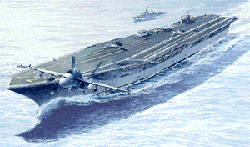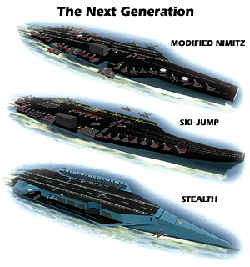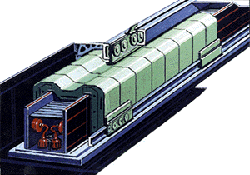21ST CENTURY CARRIER FORCE
Our naval warfare strategies will change the way America's aircraft carriers win victories at sea.
 It is a beautiful night on the water. The Gulf of Mexico is as calm as a country lake and a wispy sea breeze gently stirs the moist tropical air. Stars bright as flashbulbs speckle the cloudless sky. All this tranquillity, though, is probably lost on the pilot of the fast-approaching jet. He is about to experience the most terrifying event of his young life, his first night landing on an aircraft carrier.
It is a beautiful night on the water. The Gulf of Mexico is as calm as a country lake and a wispy sea breeze gently stirs the moist tropical air. Stars bright as flashbulbs speckle the cloudless sky. All this tranquillity, though, is probably lost on the pilot of the fast-approaching jet. He is about to experience the most terrifying event of his young life, his first night landing on an aircraft carrier.

Plans for CVX range from a conservative modified-Nimitz design to a speedy stealth platform.
From our vantage point, on the landing safety officer's platform of the USS John C. Stennis, his plane seems to hang motionless. It is an optical illusion: In fact, 51,000 pounds of F-14 Tomcat are bearing down on us at 154 mph. Less than a heartbeat after we recognize the jet's distinctive twin-fins, its tailhook hits the deck about 50 ft. to our left. It throws off a shower of sparks that follows the plane like it's a grounded Roman candle. The rolling thunder of the jet's afterburners-an insurance policy that guarantees a speedy takeoff if the arresting cable breaks-crashes through the earplugs we're wearing.
The noise stops abruptly, signaling that the plane has come to a complete stop. In the distance we can see a band of aircraft handlers rising from the shadows. They quickly inspect the plane and lock it into the nearby catapult. The same pilot spools up the twin engines. A sharp salute signals he is ready for takeoff. Enough high-pressure steam to fling a pickup truck 2 1/2 miles surges through the catapult's power cylinders. The pilot rockets into the night sky-and a new career as a naval aviator.
For more than half a century, the Navy's ability to launch and recover aircraft at sea has been the powerful swift sword of American foreign policy. The Stennis CVN-74, on which POPULAR MECHANICS has deployed, will carry this tradition forward far into the 21st century. One of eight operational Nimitz-class carriers, she traces her heritage and basic "flattop" design back more than 75 years to when the collier Jupiter was topped with a wooden flight deck and rechristened as the Navy's first aircraft carrier, the Langley (see "Navy Building Battleship Of New Design," March 1921, page 331). Born in an era when nations projected their wills from the barrels of big guns atop battleships, flattops would evolve to become the most powerful fighting machines afloat. Today, as the Navy prepares to build its last Nimitz-class carrier, the still-unnamed CVN-77, these awesome floating airports find themselves the target of the next explosive change in naval warfare.
The Last Nimitz
"CVN-77 is our transition carrier," says Rear Adm. David Putnam Sargent Jr., of the Naval Sea Systems Command in Arlington, Va. "Our objective is lowering the ownership costs of Nimitz-class [carriers] and at the same time to allow us to develop new technologies that can be used in the future." The carrier after CVN-77 currently exists as a research and development program, but it could be cast in steel before long. It is known by the code name CVX. The exact form that CVX takes will be shaped by two potentially conflicting forces: the practical lessons the Navy will learn in building CVN-77 and emerging naval strategies that reflect the new political realities of the post-Cold War era.
In 75 years of conducting air operations at sea the Navy has worked most of the bugs out of its carriers. One that persists, which the Navy hopes to avoid in CVN-77, has roused us from a sound sleep onboard the Stennis. The noise is so loud the ceiling of this stateroom-PM ranks a lieutenant commander's quarters-could be the underside of a demolition site. The next morning the ship's executive officer explains that a crew spent the night servicing a jet-blast deflector located directly overhead.
These large steel plates, one behind each of the carrier's four catapults, protect aircraft handlers from 2300 degrees F jet exhaust. The plates are cooled with seawater, which is plentiful but also corrosive. "It has been a maintenance headache on all carriers," Richard R. Doerner, design manager at Newport News Shipbuilding's Carrier Innovation Center in Newport News, Va., later tells PM. When CVN-77 puts to sea in 2008, the metal deflectors will probably be replaced with a passive heat shield to eliminate the need for seawater and its attendant maintenance problems.
Smaller Crews
This may seem like a small modification, but the Navy sees such steps as essential to making a 12-carrier fleet affordable. On average, a Nimitz-class carrier costs about $4 billion to build and $2 billion a year to operate, according to the General Accounting Office. The 80 or so planes are extra. And the fact that they become obsolete faster than the ships adds substantially to total costs. The F/A-18E/F program to equip carriers with the next generation of aircraft comes with an $81 billion price tag. Add to this the cost of the scores of ships needed to service and protect carrier battle groups and you get a sense of the cost problem. "Some members [of Congress] believe that alternatives to the Nimitz design offer a more cost-effective means of basing aircraft at sea," says defense analyst Scott C. Truver.
Following the lead of industries that have successfully used automation to reduce the size of workforces, the Navy is looking to downsize the 5000-man crews of Nimitz-class ships. Although it hasn't set precise numbers for the size of future crews, one hint of the Navy's long-term goal comes from its enthusiasm about an automated bomb-handling system that will let one sailor do work now handled by nine.
Some changes will be more obvious than others. As a Nimitz-class carrier, CVN-77 will have the same below-deck structure as her sister ships, right down to twin nuclear reactors (see "Show Of Force," March 1990, page 49). Above the flight deck the change that will most visibly set her apart will be the replacement of her island-a multistory structure resembling an airport control tower-with two low, squat control centers.
On flattops the island typically houses the helm and navigation centers, as well as observation suites for the carrier air group commander, captain and, from time to time, the admiral responsible for the battle group. From the observation areas, the views of the flight deck and ocean are spectacular. Unfortunately, the radar return that bounces off these towers makes a carrier stand out like the proverbial sore thumb. Current plans for CVN-77 call for replacing the broad expanses of windows with broad expanses of display screens that will show satellite and combat-radar imagery. The change will make it possible to reduce the single, tall island to two small structures shaped to scatter rather than reflect signals transmitted by enemy radar.
Whatever the eventual crew size and deck configuration of CVN-77, defense analysts believe one thing is almost certain: She is likely to be the last of the large flattops. However, this downsizing isn't the Navy's idea, but the enemy's.

The electromagnetic catapult is the key to making smaller aircraft carriers.
New Enemies
"When the steel for CVX is poured in 2006, the final shape will represent almost 80 years of carrier development," says Capt. Mark O'Hare, the Navy's carrier program manager. The overall shape of the flattop carrier was cast during the Second World War. Changes made to carriers during the Cold War era stemmed mainly from the switch from oil to nuclear fuel and the need to fine-tune weapons systems to keep ahead of the Soviet navy.
After preparing for so long to engage the Soviet Union on the deep blue waters of the open seas, naval aviation planners now find themselves facing a totally unexpected turn of events. "With the Soviet Union's collapse in 1991 there is simply no blue-water enemy to sink," says Andrew F. Krepinevich Jr., of the Center for Strategic and Budgetary Assessments, a Washington, D.C.-based think tank that analyzes defense strategies.
Krepinevich and some other military analysts see this lull in hostilities as the ideal time to rethink naval aviation strategy in general, and carrier design in specific. A good starting point, he suggests, is to look at what the countries at the top of our current enemies list-Iran, Iraq and North Korea-are buying when they shop at the international arms bazaar.
Cheap But Deadly
Naval analysts who have performed this exercise believe none of our potential enemies has the slightest interest in engaging the U.S. Navy in blue water-where their defeat would be a foregone conclusion. Instead, they appear to be pursuing a naval warfare doctrine aimed at luring our Navy into near-shore-littoral-waters, where air carriers and the missile-firing ships that defend them are most vulnerable to cheap antiship mines and accurate antiship cruise missiles.
It is a strategy that has already proved to be deadly effective. "Of the 18 Navy ships seriously damaged in operations since 1950, 14 were due to mines," Krepinevich tells PM. "During the Kuwaiti reflagging operation in the late 1980s, the guided-missile frigate USS Samuel B. Roberts was damaged by a World War I-era mine in the Persian Gulf. During the Gulf War the guided-missile cruiser USS Princeton and amphibious-assault ship USS Tripoli were both damaged by mines that cost less than $1500 each." The Navy also felt the murderous sting of high-velocity, sea-skimming antiship missiles when two French-built Exocet missiles launched by Iraq killed 37 sailors aboard the guided-missile frigate USS Stark prior to the Gulf War.
The Navy says its next class of carrier-CVX-must be able to deal with such threats without costing so much that their price tags turn taxpayers into isolationists. "The reason we are going to CVX is because the current platforms are expensive," says Robert E. Davis, CVX design manager at Newport News Shipbuilding.
After reducing crew size, another way to wring more value from multibillion-dollar ships is to simply make them last longer. The previous class of aircraft carriers was designed for 30 years of service, after which a major retrofit program could keep them in fighting trim for another 20 years (see "Carrier Reborn," Sept. 1991, page 34). The Stennis has an estimated life of 50 years. From the start, the CVX class is being designed for a 55-year life span, during which it could see as many as 4 generations of combat systems, 5 generations of aircraft and 10 generations of computers.
Stealthy Approach
To make the CVX class more survivable in littoral combat, the Navy plans to make these carriers smaller, faster-and perhaps stealthy. In the Nimitz-class carriers size is largely a function of the catapult and the nuclear powerplant that, among other tasks, makes the steam to drive it. One of the most ambitious proposals for CVX is to scrap the massive steam-driven catapult and replace it with a lighter-weight electromagnetic system. Kaman Electromagnetics of Hudson, Mass., claims that its system operates at 70% efficiency versus 6% for steam, and could cut the weight of a 100,000-ton carrier by 1 percent.
Getting out of the steam-making business would enable the Navy to cut its cord to nuclear power. Advanced turbine-electric powerplants that drive superconducting motors are currently being eyed as a possible alternative. Cost projections show that non-nuclear CVX-class carriers would be $1 billion cheaper to build and about $39 million a year less expensive to operate, says Stuart L. Slade, a senior naval systems analyst for Forecast International/DMS of Newton, Conn.
While the weight reduction from the new catapult and powerplant would make the carriers faster, their smaller size could help make them stealthier. No one expects a carrier of any size to go undetected in enemy waters for long. However, by reducing the radar cross section of very fast carriers to roughly the size of, say, a fishing trawler, stealth technology could delay detection long enough for a carrier to launch and recover aircraft.
The trick to hiding carriers from radar is to control how they bounce back the radar transmissions that strike them. "Imagine standing in a darkened room with a torch and trying to spot a mirror," says Brian Spilman, a weapons engineer at British shipbuilder Vosper Thorneycroft. "The mirror will only reflect the light back to you if it's perpendicular to the beam" and your line of vision. The British journal New Scientists reports that Vosper Thorneycroft's Sea Wraith II, a proposed British warship, can use radar deflection to hide. Jane's Defence Weekly, a military journal that tracks weapons development, says that the Swedish government is even further ahead and has begun construction of a 28-ship, all-stealth navy to become operational over the next 15 years.
For the moment the Navy is neither encouraging nor discouraging the imaginative ideas being floated for CVX. What little is being said, however, may be prophetic. "When we design support systems on a carrier, they will be usable for both the CVN-77 and the CVX, so we don't have to repeat the R&D investment," says Adm. Sargent. "I don't think it is very smart to have a new class of carrier and have it be the first time a new technology has been used."
If the Navy holds true to this thinking, CVN-77 and CVX could bear a stronger resemblance to carrier fleets of the past than to the visionaries' dreams for the future.
 It is a beautiful night on the water. The Gulf of Mexico is as calm as a country lake and a wispy sea breeze gently stirs the moist tropical air. Stars bright as flashbulbs speckle the cloudless sky. All this tranquillity, though, is probably lost on the pilot of the fast-approaching jet. He is about to experience the most terrifying event of his young life, his first night landing on an aircraft carrier.
It is a beautiful night on the water. The Gulf of Mexico is as calm as a country lake and a wispy sea breeze gently stirs the moist tropical air. Stars bright as flashbulbs speckle the cloudless sky. All this tranquillity, though, is probably lost on the pilot of the fast-approaching jet. He is about to experience the most terrifying event of his young life, his first night landing on an aircraft carrier. 
